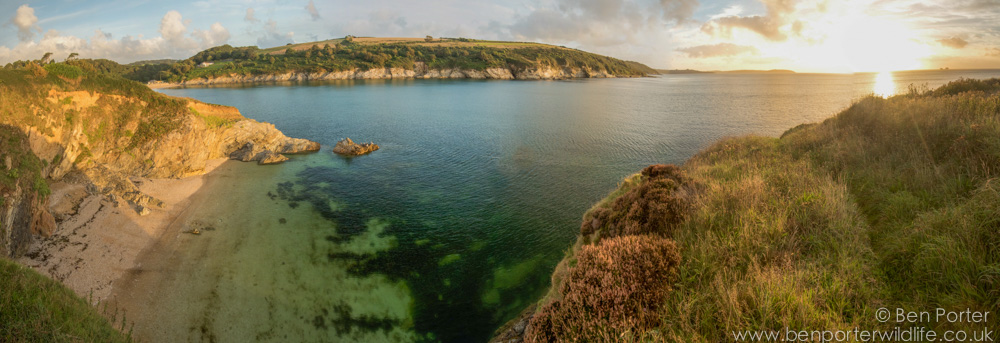I arrived in Falmouth somewhat dazed after the typical 12-hour train journey from North Wales, which is nevertheless a very scenic ride for the first five hours! I spent the following days settling down and running various trips and events with 'ecosoc' (the ecological society on campus) for freshers week: birding trips around the county, moth trapping, bird ringing etc. It has been great to see all the new and enthusiastic students arriving for their various degrees, and also to get out an about around this stunning area of the country!
Maenporth at sunrise, which is around 15 minutes away from where I'm currently staying. A home from home!
At the end of my first day, I decided to pay my local patch a visit - namely that of Argal and College Reservoirs just a few minutes from my caravan. It was getting a little dark at 7pm, but as soon as I arrived at the reservoir I saw this lively chap fluttering around and plunge-diving for fish. I will be writing a full blog post about the find, but I basically screwed up (thinking it was a juv black tern) before being corrected that it was in fact a WHISKERED TERN! Thankfully it was present the next day, and showed brilliantly up until the 15th (no sign for the last few days).
More to come of this beauty...
Whiskered Tern
The water level in College and Argal Reservoir is incredibly low, which means that a lot of vegetation has sprung up around the perimeter and a muddy bank has been exposed. I have to say that the habitat is looking better than ever for waders and ducks, so I look forward to seeing what it will produce this autumn and winter.
I have paid a visit to a variety of sites with a couple of birding & photography friends this week. One particularly enjoyable afternoon was spent looking for a lovely variety of different insects at the nearby Bisso Valley with photographer Max Thompson and birder Liam Langley. We saw some great species...
female Common Hawker ovipositing
Emerald Damselfly
A rather small Common Toad
Sun Fly (Helophilus pendulus)
Froghopper sp. - not sure what species?
Bissoe has some perfect grounds to play host to some huge gatherings of Ivy Mining Bees (Colletes hederae). They construct their nests in tunnels in the sandy ground, and can number in the tens of thousands in some places in the UK!
Small Copper
As mentioned before, I have been taking a couple of groups out on birding trips for freshers events, visiting sites like Hayle Estuary and the Lizard Peninsula. Hayle produced an unexpectedly high number of wildfowl and waders considering the time of year, with a rising tide forcing them close to the causeway and thus giving us some great views...hundreds of Teals, Wigeons, plenty of Curlews, Bar-tailed and Black-tailed Godwits, Grey and Golden Plovers, Ruff, Greenshanks, Little Egrets, Common Sandpipers and much more were recorded...
Yesterday (17th), I paid a visit to Land's End with birders and Phd students George Swan and Liam Langley to cash in on some of the eastern jewels that have been turning up all across the country. We began by scrutinising the hedgerows and heath around Land's End, before heading to Porthgwarra to catch up with a smart juvenile Red-backed Shrike. The bushes and heathland around Land's End was covered in Stonechats (upwards of 40 easily), along with 15 Whinchats, plenty of Wheatears, a good stream of Swallows and House Martins overhead, and a couple of these smart lookers (which took us most of the morning to find!)
Wryneck
Wheatear
The highlight of the day for me was seeing this Common Buzzard fly over with an Adder gripped firmly in its talons! An amazing sight, especially when another Buzzard was in pursuit giving whistling calls in attempt to pinch a little of this rather sizeable snack. Only my second UK adder, and in the talons of a Buzzard!
My course begins in earnest this week, but I hope to get out and about as much as possible - I will endeavour to keep my blog updated in the coming weeks, but we'll see how the workload pans out!















No comments:
Post a Comment